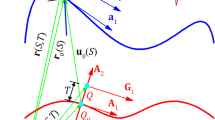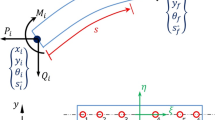Abstract
This paper investigates the nonlinear analysis of planar beams based on the total Lagrangian Timoshenko theory. The isogeometric analysis (IGA) is adopted as the numerical solution technique. Nurbs functions are used to discretize the unknown kinematics, including displacements and rotation, as well as the linearized governing equations. The virtual work principle is employed to derive the nonlinear governing equations and boundary conditions, which are then solved using the Newton-Raphson algorithm. The results of the proposed formulation have been validated by analytical results, as well as through assessments against available numerical results reported in the relevant literature, demonstrating the efficiency and accuracy of the proposed formulation.







Similar content being viewed by others
References
Scaramozzino D, Lacidogna G, Carpinteri A (2020) New trends towards enhanced structural efficiency and aesthetic potential in tall buildings: the case of diagrids. Appl Sci 10(11):3917
De Lorenzis L, Wriggers P, Hughes TJ (2014) Isogeometric contact: a review. GAMM-Mitteilungen 37(1):85–123
Reddy JN, Wang CM, Lee KH (1997) Relationships between bending solutions of classical and shear deformation beam theories. Int J Solids Struct 34(26):3373–3384
Reissner E (1973) On one-dimensional large-displacement finite-strain beam theory. Stud Appl Math 52(2):87–95
Simo JC (1985) A finite strain beam formulation. The three-dimensional dynamic problem. Part I. Comput Methods Appl Mech Eng 49(1):55–70
Simo JC, Vu-Quoc L (1986) A three-dimensional finite-strain rod model. Part II: computational aspects. Comput Methods Appl Mech Eng 58(1):79–116
Jelenić G, Crisfield M (1999) Geometrically exact 3D beam theory: implementation of a strain-invariant finite element for statics and dynamics. Comput Methods Appl Mech Eng 171(1–2):141–171
Ghosh S, Roy D (2008) Consistent quaternion interpolation for objective finite element approximation of geometrically exact beam. Comput Methods Appl Mech Eng 198(3–4):555–571
Betsch P, Steinmann P (2002) Frame-indifferent beam finite elements based upon the geometrically exact beam theory. Int J Numer Methods Eng 54(12):1775–1788
Kapania RK, Li J (2003) On a geometrically exact curved/twisted beam theory under rigid cross-section assumption. Comput Mech 30(5):428–443
Mäkinen J (2007) Total Lagrangian Reissner’s geometrically exact beam element without singularities. Int J Numer Methods Eng 70(9):1009–1048
Auricchio F, Carotenuto P, Reali A (2008) On the geometrically exact beam model: a consistent, effective and simple derivation from three-dimensional finite-elasticity. Int J Solids Struct 45(17):4766–4781
Beirão da Veiga L, Lovadina C, Reali A (2012) Avoiding shear locking for the Timoshenko beam problem via isogeometric collocation methods. Comput Methods Appl Mech Eng 241:38–51
Auricchio F, Beirão da Veiga L, Kiendl J, Lovadina C, Reali A (2013) Locking-free isogeometric collocation methods for spatial Timoshenko rods. Comput Methods Appl Mech Eng 263:113–126
Weeger O, Yeung S-K, Dunn ML (2017) Isogeometric collocation methods for Cosserat rods and rod structures. Comput Methods Appl Mech Eng 316:100–122
Shabana A (1996) Finite element incremental approach and exact rigid body inertia. ASME J Mech Des 118(2):171–178
Gerstmayr J, Shabana AA (2006) Analysis of thin beams and cables using the absolute nodal co-ordinate formulation. Nonlinear Dyn 45:109–130
Sopanen JT, Mikkola AM (2003) Description of elastic forces in absolute nodal coordinate formulation. Nonlinear Dyn 34:53–74
Hughes TJ, Cottrell JA, Bazilevs Y (2005) Isogeometric analysis: CAD, finite elements, NURBS, exact geometry and mesh refinement. Comput Methods Appl Mech Eng 194(39–41):4135–4195
Cottrell JA, Hughes TJR, Bazilevs Y (2009) Isogeometric analysis: toward integration of CAD and FEA. John Wiley & Sons, Singapore
Vo D, Nanakorn P, Bui TQ (2020) A total Lagrangian Timoshenko beam formulation for geometrically nonlinear isogeometric analysis of spatial beam structures. Acta Mechanica 231:3673–3701
Zhang G, Alberdi R, Khandelwal K (2016) Analysis of three-dimensional curved beams using isogeometric approach. Eng Struct 117:560–574
Cazzani A, Malagù M, Turco E (2016) Isogeometric analysis of plane-curved beams. Math Mech Solids 21(5):562–577
Borković A, Kovačević S, Radenković G, Milovanović S, Guzijan-Dilber M (2018) Rotation-free isogeometric analysis of an arbitrarily curved plane Bernoulli-Euler beam. Comput Methods Appl Mech Eng 334:238–267
Bauer AM, Breitenberger M, Philipp B, Wüchner R, Bletzinger K-U (2016) Nonlinear isogeometric spatial Bernoulli beam. Comput Methods Appl Mech Eng 303:101–127
Yin S, Hale JS, Yu T, Bui TQ, Bordas SP (2014) Isogeometric locking-free plate element: a simple first order shear deformation theory for functionally graded plates. Compos Struct 118:121–138
Zhao G, Du X, Wang W, Liu B, Fang H (2017) Application of isogeometric method to free vibration of Reissner-Mindlin plates with non-conforming multi-patch. Comput-Aided Des 82:127–139
Liu N, Jeffers AE (2018) A geometrically exact isogeometric Kirchhoff plate: Feature-preserving automatic meshing and \(c^{1}\) rational triangular Bézier spline discretizations. Int J Numer Methods Eng 115(3):395–409
Kiendl J, Bletzinger K-U, Linhard J, Wüchner R (2009) Isogeometric shell analysis with Kirchhoff-Love elements. Comput Methods Appl Mech Eng 198(49–52):3902–3914
Dornisch W, Müller R, Klinkel S (2016) An efficient and robust rotational formulation for isogeometric Reissner-Mindlin shell elements. Comput Methods Appl Mech Eng 303:1–34
Echter R, Oesterle B, Bischoff M (2013) A hierarchic family of isogeometric shell finite elements. Comput Methods Appl Mech Eng 254:170–180
Bandara K, Cirak F (2018) Isogeometric shape optimisation of shell structures using multiresolution subdivision surfaces. Comput-Aided Des 95:62–71
Bathe K-J, Lee P-S, Hiller J-F (2003) Towards improving the MITC9 shell element. Comput Struct 81(8–11):477–489
Nanakorn P, Vu LN (2006) A 2D field-consistent beam element for large displacement analysis using the total Lagrangian formulation. Finite Elem Anal Des 42(14–15):1240–1247
Wang CM, Reddy J, Lee KH (2000) Shear deformable beams and plates: relationships with classical solutions. Elsevier, Oxford
Author information
Authors and Affiliations
Contributions
All authors contributed to the design and implementation of the research, to the analysis of the results and to the writing of the manuscript.
Corresponding author
Ethics declarations
Competing interest
The authors declare no competing interests.
Additional information
Publisher's Note
Springer Nature remains neutral with regard to jurisdictional claims in published maps and institutional affiliations.
Rights and permissions
Springer Nature or its licensor (e.g. a society or other partner) holds exclusive rights to this article under a publishing agreement with the author(s) or other rightsholder(s); author self-archiving of the accepted manuscript version of this article is solely governed by the terms of such publishing agreement and applicable law.
About this article
Cite this article
Abdelfettah, S. Nurbs-based Timoshenko formulation of a geometrically nonlinear planar beam. J Eng Math 146, 12 (2024). https://doi.org/10.1007/s10665-024-10362-2
Received:
Accepted:
Published:
DOI: https://doi.org/10.1007/s10665-024-10362-2




